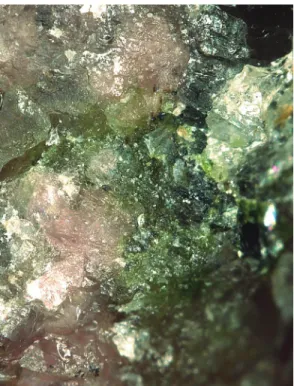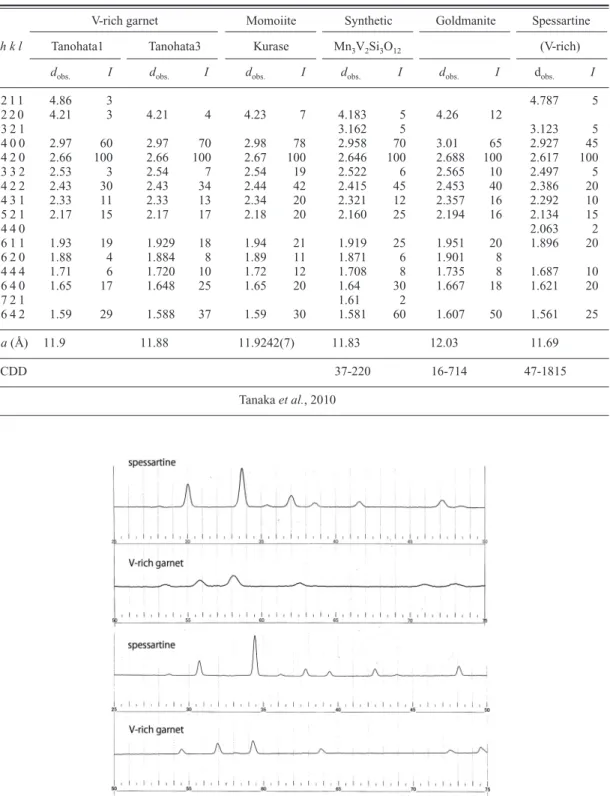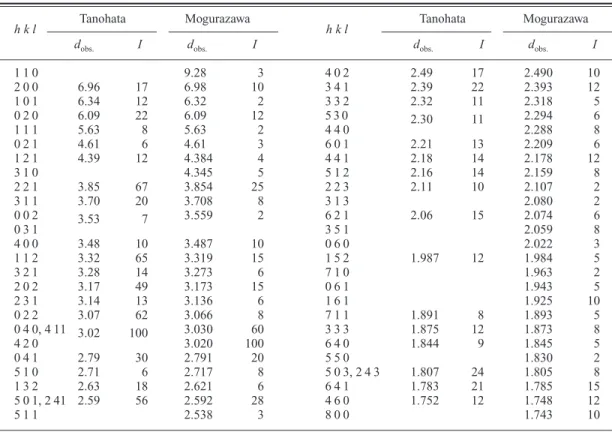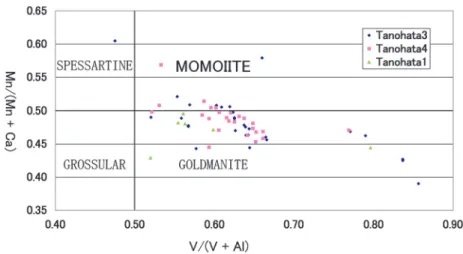Introduction
Momoiite, (Mn
2+,Ca)
3(V
3+,Al)
2Si
3O
12, was re- cently described by Tanaka et al. (2010) from the Kurase mine of Ehime Prefecture, the Hokkejino mine of Kyoto Prefecture and the Fujii mine of Fukui Prefecture, Japan. In 1964, Momoi report- ed the occurrence of Mn- and V-rich garnet from the Yamato mine, Kagoshima Prefecture, Japan and proposed a new name of “yamatoite” for the hypothetical end-member, Mn
2+3V
3+2Si
3O
12. The reported Mn- and V-rich garnet from the Yamato mine, however, did not exceed 50% of Mn
2+3V
3+2Si
3O
12mole (Momoi, 1964). There-
fore, the Commission on New Minerals, Nomen- clature and Classification, International Miner- alogical Association approved the proposal by Tanaka et al. (New Mineral 2009-026), that is, a mineral name of Mn
2+3V
3+2Si
3O
12is momoiite in- stead of “yamatoite”.
Nagashimalite is a V-analogue of taramellite and was described as a new mineral from the metamorphosed manganese ore deposit of the Mogurazawa mine, Gumma Prefecture, Japan by Matsubara and Kato (1980).
During the survey on the manganese minerals from the Tanohata mine, Iwate Prefecture, Japan, we have found momoiite and nagashimalite in
Momoiite and nagashimalite from the Tanohata mine, Iwate Prefecture, Japan
Satoshi Matsubara
1, Ritsuro Miyawaki
1, Kazumi Yokoyama
1, Masako Shigeoka
1, Hiroshi Miyajima
2, Yasumitsu Suzuki
3, Osamu Murakami
4and Takashi Ishibashi
51Department of Geology and Paleontology, National Museum of Nature and Science, 3–23–1 Hyakunin-cho, Shinjuku, Tokyo 169–0073, Japan
2Fossa Magna Museum, Miyama Park, Itoigawa, Niigata 941–0056, Japan
34–3–15 Miyatacho, Hitachi, Ibaraki 317–0055, Japan
4102 Oyama Aza Touge, Isawa, Oshu, Iwate 023–0402, Japan
5Masutomi Museum, Karasuma Demizu, Kamigyo, Kyoto 602–8012, Japan
Abstract Momoiite and nagashimalite occur in rhodonite-quartz ore in association with V-bear- ing aegirine, V-bearing allanite, V-bearing titanite, Sr-bearing fluorapatite, pyrophanite, hyalophane and unidentified REE-Sr-Ti-V silicate from the metamorphosed manganese ore deposit of the Tanohata mine, Iwate Prefecture, Japan. Vanadium-bearing garnet including momoiite (Mn3V2Si3O12) occurs as dark green grains up to 2 mm across in rhodonite-quartz ore. The chemical composition of V-bearing garnet varies widely especially in Mn/Ca and V/Al. An electron microprobe analysis for the most Mn- and V-rich area corresponding to momoi- ite component gave SiO2 34.04, TiO2 0.93, Al2O3 6.96, V2O3 19.85, FeO (as total Fe) 1.11, MnO 23.73, MgO 0.10, CaO 13.64, total 100.36 wt.%. The empirical formula is:
(Mn1.70Ca1.24Fe2+0.05Mg0.01)Í3.00(V1.35Al0.60Ti0.06)Í2.01(Si2.88Al0.09Fe3+0.03)Í3.00O11.96 on the basis of total metal8 with separating Fe2+(for X[8]-site) and Fe3+(for T[4]-site). The powder X-ray diffrac- tion peaks appear rather broad in accordance with heterogeneity of the chemical composition. The five strongest diffractions are [d(Å), (I), hkl]: 2.97(60)400, 2.66(100)420, 2.43(30)422, 1.585(29)642 and 1.481(10)800. Nagashimalite is found as dark greenish prismatic crystal up to 1 m long in association with V-bearing garnet and quartz. The average of 12 electron microprobe analyses gave SiO233.56, TiO25.29, Fe2O3(as total Fe) 2.33, B2O34.56, V2O312.15, MnO 0.17, BaO 39.76, SrO 1.01, Cl 1.98, –OCl 0.44, total 100.55 wt.%. The cell parameters of na- gashimalite are, a13.929(8), b12.150(9), c7.119(4)Å, V1204.8(13) Å3.
Key wards : momoiite, nagashimalite, Tanohata mine
world and brief discussion on the chemical com- position and crystallography of momoiite.
Occurrence
The manganese ore deposits of the Tanohata mine are contact metamorphosed and metasoma- tized by granodiorite (Nambu et al., 1969). We collected the studied specimens from the dump of No. 3 (Matsumaezawa) orebody where new V- rich minerals such as suzukiite (Watanabe et al., 1973), V-bearing potassicleakeite (Matsubara et
al., 2002) and watatsumiite (Matsubara et al.,2003) are found. These minerals occur in quartz- rich pegmatite-like veins including rhodonite, serandite, V-bearing aegirine, V-bearing titanite, yoshimuraite, V-bearing allanite, an unidentified REE-Sr-Ti-silicate, K-feldspar, hyalophane, Sr- bearing fluorapatite and pyrophanite.
The aggregates of V-rich garnet including mo- moiite component is found as dark green grain less than 2 mm across (Fig. 1). Under the micro- scope the aggregates is pale yellowish green to pale green (Fig. 2) and shows partially distinct anisotropic property in crossed polars (Fig. 3).
Nagashimalite occurs as dark green prismatic or anhedral crystals less than 1 mm length. It has re- markable pleochroism with yellowish brown to greenish brown color under the microscope (Fig.
4).
X-ray Crystallography
The powder X-ray diffraction patterns of two aggregates of V-rich garnet including momoiite were obtained by using a Gandolfi camera, 114.6 mm in diameter, employing Ni-filtered Cu-Ka radiation. This diffraction patterns indicate those of general garnet (Table 1), but appear distinctly broad in compare with a normal spessartine (Fig.
5). The representative unit cell parameters calcu- lated in the cubic system are as follows: a 11.88 Å (Tanohata3). Compared with the unit
a
11.69 Å (ICDD 47-1815) (Table 1), the para- meter of the present V-rich garnet including mo- moiite is located between those of synthetic Mn
3V
2Si
3O
12and goldmanite.
Also the powder X-ray diffraction pattern of nagashimalite was obtained by using the Gan- dolfi camera. The pattern resembles that of the original nagashimalite from the Mogurazawa mine, Gumma Prefecture, Japan (Matsubara and Kato, 1980) (Table 2). The unit cell parameters are calculated in the orthorhombic system as fol- lows: a 13.929(8), b 12.150(9), c 7.119(4) Å,
V1204.8(13) Å
3. Compared with the unit cell parameters of the Mogurazawa material, a-axis is slightly shorter, and b- and c-axes are slightly longer.
Chemical Composition
Excluding B, chemical analyses of the present V-rich garnet and nagashimalite were carried out using a Link Systems energy dispersive X-ray spectrometer (QX-2000) for Mn, Fe, V, Al, Ti, Ba, Sr, Cl, Ca and Si. The standard materials used were Mn for Mn, Fe
2SiO
4for Fe, V for V, sillimanite for Al, TiO
2for Ti, BaF
2for Ba, SrF
2for Sr, vanadinite for Cl and wollastonite for Ca and Si, respectively. Boron was analyzed with a WDS (JXA 8800) using danburite standard.
Table 3 and Table 4 show the representative re- sult for goldmanite-momoiite and the average of 12 analyses of nagashimalite compared with data of the original momoiite from the Kurase mine and nagashimalite from the Mogurazawa mine, respectively. The empirical formula of the high- est momoiite component (Tanohata3-21) is (Mn
1.70Ca
1.24Fe
2+0.05Mg
0.01)
Í3.00(V
1.35Al
0.60Ti
0.06)
Í2.01
(Si
2.88Al
0.09Fe
3+0.03)
Í3.00O
11.96on the basis of
total metal 8 with separating Fe
2+(for X
[8]-site)
and Fe
3+(for T
[4]-site). The empirical formula of
nagashimalite is (Ba
3.71Sr
0.14)
Í3.85(V
2.32Ti
0.95Fe
0.42Mn
0.03)
Í3.72Si
8B
1.88O
28.28Cl
0.80on the basis of
Si 8. In comparison with the formula of the
Moguraza material, Ba
4.00(V
3.30Ti
0.51Mn
0.10)
Í3.91Si
8B
1.71O
27.64Cl
0.72(OH)
1.28, the present material is characterized of rich in Ti and Fe.
Discussion
The chemical variation of momoiite from three localities reported by Tanaka et al. (2010) and the Tanohata mine indicate similar trend indicat- ing solid solution from goldmanite to spessartine through the part of momoiite field (Fig. 6). This property may be derived from the similar geolog- ical condition, that is, no high pressure and tem- perature regional or contact metamorphism. We agree the consideration that the formation of near end member of momoiite is undesirable under such low-to medium-metamorphic conditions
Fig. 1. Microphotograph of the aggregate of V- rich garnet including momoiite. Field view:
approximately 2.94.8 mm.
Fig. 2. Microphotograph of the thin section of V- rich garnet including momoiite. One polar.
Field view: approximately 1.20.9 mm.
Fig. 3. Microphotograph of the same thin section to Fig. 2. Anisotropic property is visible under crossed polars. Field view: approximately 1.2 0.9 mm.
Fig. 4. Microphotograph of the thin section of nagashimalite in quartz crystal enclosed in V- rich garnet including momoiite. One polar.
Field view: approximately 1.20.9 mm.
Fig. 5. Comparison of powder X-ray diffraction patterns between spessartine from Kunisaki, Hyogo Prefecture, Japan and V-rich garnet including momoiite.
V-rich garnet Momoiite Synthetic Goldmanite Spessartine
h k l Tanohata1 Tanohata3 Kurase Mn3V2Si3O12 (V-rich)
dobs. I dobs. I dobs. I dobs. I dobs. I dobs. I
2 1 1 4.86 3 4.787 5
2 2 0 4.21 3 4.21 4 4.23 7 4.183 5 4.26 12
3 2 1 3.162 5 3.123 5
4 0 0 2.97 60 2.97 70 2.98 78 2.958 70 3.01 65 2.927 45
4 2 0 2.66 100 2.66 100 2.67 100 2.646 100 2.688 100 2.617 100
3 3 2 2.53 3 2.54 7 2.54 19 2.522 6 2.565 10 2.497 5
4 2 2 2.43 30 2.43 34 2.44 42 2.415 45 2.453 40 2.386 20
4 3 1 2.33 11 2.33 13 2.34 20 2.321 12 2.357 16 2.292 10
5 2 1 2.17 15 2.17 17 2.18 20 2.160 25 2.194 16 2.134 15
4 4 0 2.063 2
6 1 1 1.93 19 1.929 18 1.94 21 1.919 25 1.951 20 1.896 20
6 2 0 1.88 4 1.884 8 1.89 11 1.871 6 1.901 8
4 4 4 1.71 6 1.720 10 1.72 12 1.708 8 1.735 8 1.687 10
6 4 0 1.65 17 1.648 25 1.65 20 1.64 30 1.667 18 1.621 20
7 2 1 1.61 2
6 4 2 1.59 29 1.588 37 1.59 30 1.581 60 1.607 50 1.561 25
a(Å) 11.9 11.88 11.9242(7) 11.83 12.03 11.69
ICDD 37-220 16-714 47-1815
Tanaka et al., 2010
proposed by Tanaka et al. (2010).
In Ca rich-garnet, especially solid solution from grossular to andradite, anisotropic property is commonly observed. Such garnet is generally
not cubic and this suggests the Tanohata V-rich garnet solid solution having broad powder X-ray pattern and partial anisotropic property also to be not cubic. The original momoiite was calculated
Table 2. X-Ray powder diffraction data for nagashimalite from the Tanohata and Mogurazawa mine.
Tanohata Mogurazawa Tanohata Mogurazawa
h k l
dobs. I dobs. I
h k l
dobs. I dobs. I
1 1 0 9.28 3 4 0 2 2.49 17 2.490 10
2 0 0 6.96 17 6.98 10 3 4 1 2.39 22 2.393 12
1 0 1 6.34 12 6.32 2 3 3 2 2.32 11 2.318 5
0 2 0 6.09 22 6.09 12 5 3 0 2.30 11 2.294 6
1 1 1 5.63 8 5.63 2 4 4 0 2.288 8
0 2 1 4.61 6 4.61 3 6 0 1 2.21 13 2.209 6
1 2 1 4.39 12 4.384 4 4 4 1 2.18 14 2.178 12
3 1 0 4.345 5 5 1 2 2.16 14 2.159 8
2 2 1 3.85 67 3.854 25 2 2 3 2.11 10 2.107 2
3 1 1 3.70 20 3.708 8 3 1 3 2.080 2
0 0 2 3.53 7 3.559 2 6 2 1 2.06 15 2.074 6
0 3 1 3 5 1 2.059 8
4 0 0 3.48 10 3.487 10 0 6 0 2.022 3
1 1 2 3.32 65 3.319 15 1 5 2 1.987 12 1.984 5
3 2 1 3.28 14 3.273 6 7 1 0 1.963 2
2 0 2 3.17 49 3.173 15 0 6 1 1.943 5
2 3 1 3.14 13 3.136 6 1 6 1 1.925 10
0 2 2 3.07 62 3.066 8 7 1 1 1.891 8 1.893 5
0 4 0, 4 11 3.02 100 3.030 60 3 3 3 1.875 12 1.873 8
4 2 0 3.020 100 6 4 0 1.844 9 1.845 5
0 4 1 2.79 30 2.791 20 5 5 0 1.830 2
5 1 0 2.71 6 2.717 8 5 0 3, 2 4 3 1.807 24 1.805 8
1 3 2 2.63 18 2.621 6 6 4 1 1.783 21 1.785 15
5 0 1, 2 41 2.59 56 2.592 28 4 6 0 1.752 12 1.748 12
5 1 1 2.538 3 8 0 0 1.743 10
Tanohata: this study.
Mogurazawa: Matsubara and Kato (1980).
Table 3. Chemical compositions of momoiite (Tanohata3 and 4) and goldmanite (Tanohata1), and momoiite from the Kurase mine (Tanaka et al., 2010).
MOMOIITE GOLDMANITE
Tanohata3 Tanohata4 Kurase* Tanohata1
21 31 48 65 4
SiO2 34.04 34.39 34.86 34.45 35.02 35.60
Al2O3 6.96 9.22 9.89 9.58 5.12 8.30
V2O3 19.85 16.78 16.58 16.51 21.96 15.55
TiO2 0.93 0.67 0.53 0.64 nd 0.71
FeO 1.11 1.37 1.51 1.55 0.05 1.43
MnO 23.73 21.49 23.42 23.93 24.74 21.06
MgO 0.10 0.10 0.10 0.09 0.28 0.09
CaO 13.64 15.62 14.01 14.09 12.24 16.93
Total 100.36 99.64 100.90 100.84 99.41 99.67
* : Tanaka et al.(2010)
as cubic using powder X-ray diffraction data and by observation of isotropic property. Although we tentatively assign V-rich garnet including mo- moiite to be cubic, it is uncertain whether our material is real cubic or not. In order to solve this problem we have to analyze the structure using a single crystal.
References
Matsubara, S., and Kato, A. (1980) Nagashimalite, Ba4(V3+,Ti)4[(O,OH)2|Cl|Si8B2O27], a new mineral from the Mogurazawa mine, Gumma Prefecture, Japan. Min- eralogical Journal, 10, 122–130.
Matsubara, S., Miyawaki, R., Kurosawa, M., and Suzuki, Y. (2002) Potassicleakeite, a new amphibole from the Tanohata mine, Iwate Prefecture, Japan. Journal of Mineralogical and Petrological Sciences, 97, 177–184.
Matsubara, S., Miyawaki, R., Kurosawa, M., and Suzuki, Y. (2003) Watatsumiite, KNa2LiMn2V2Si8O24, a new mineral from the Tanohata mine, Iwate Prefecture, Japan. Journal of Mineralogical and Petrological Sci- ences, 98, 142–150.
Momoi, H. (1964) A new vanadium garnet, (Mn,Ca)3V2Si3O12, from the Yamato mine, Amami Is- lands, Japan. Memoirs of the Faculty of Science, Kyushu University, Series D, 15, 73–78.
Nambu, M., Tanida, K., and Kumagai, S. (1969) Man- ganese Deposits in Kitakami Mountainland. I, pp146, Iwate Prefecture (in Japanese).
Tanaka, H., Endo, S., Minakawa, T., Enami, M., Nishio- Hamane, D., Miura, H., and Hagiwara, A. (2010) Mo- moiite, (Mn2+,Ca)3(V3+,Al)2Si3O12, a new manganes Vanadium garnet from Japan. Journal of Mineralogical and Petrological Sciences, 105, 92–96.
Watanabe, T., Yui, S., Kato, A., and Tsuzuki, Y. (1973) A new Ba-V-silicate from the Tanohata mine, Iwate Pre- fecture. Abstracts of Autumn Meeting of Japan Associ- ation of Mineralogy, Petrology and Economic Geology, Mineralogical Society of Japan and Society of Mining Geologists of Japan. A24 (in Japanese).
Fig. 6. Mn/(MnCa) vs. V/(VAl) diagram in V-rich garnets including momoiite.
Table 4. Chemical compositions of nagashimalite from the Tanohata mine and nagashimalite from the Mogurazawa mine (Matsubara and Kato, 1980).
wt.% Tanohata Mogurazawa
SiO2 33.56 32.37
V2O3 12.15 16.65
TiO2 5.29 2.75
Fe2O3 2.33 0
MnO 0.17 0.48
BaO 39.76 41.36
SrO 1.01 0
B2O3 4.56 4.0
Cl 1.98 1.73
H2O 0.77*
–OCl2 0.44 0.39
Total 100.55 99.72



